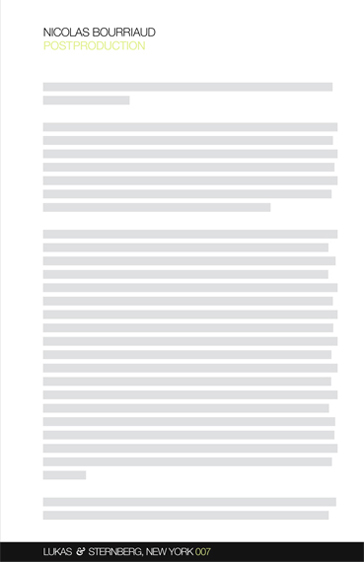Nicolas Bourriaud: Postproduction: Culture as Screenplay: How Art Reprograms the World (2002–) [EN, ES, CZ, HU, RO, BR-PT]
Filed under book | Tags: · 1990s, aesthetics, art history, art theory, contemporary art

“In this book, French writer and curator Nicolas Bourriaud discusses how, since the early nineties, an ever increasing number of artworks have been created on the basis of preexisting works; more and more artists interpret, reproduce, re-exhibit, or use works made by others or available cultural products.
This art of postproduction seems to respond to the proliferating chaos of global culture in the information age, which is characterized by an increase in the supply of works and the art world’s annexation of forms ignored or disdained until now.”
First published in French in 2002.
Translated by Jeanine Herman
Publisher Lukas & Sternberg, New York, 2002
Second edition, with a new preface, August 2005
ISBN 0974568899
96 pages
Review: Hal Foster (London Review of Books, 2003).
Publisher (EN)
Postproduction (English, trans. Jeanine Herman, 2005, updated on 2023-7-21)
Postproducción (Spanish, trans. Silvio Mattoni, 2004, added on 2023-7-21)
Postprodukce (Czech, trans. Petr Turek, 2004, added on 2014-2-25)
Utómunkálatok (Hungarian, trans. Jancsó Júlia, 2007, 55 MB, no OCR, updated on 2023-7-21)
Postproducţie (Romanian, trans. Cristian Nae, 2007, 56 MB, added on 2024-2-20)
Postprodukce (BR-Portuguese, trans. Denise Bottmann, 2009, added on 2024-2-20)
Petra Kuppers: The Scar of Visibility: Medical Performances and Contemporary Art (2007)
Filed under book | Tags: · art, body, contemporary art, medicine, performance art, technology, visual culture

“Contemporary visual and performance artists have adopted modern medical technologies such as MRIs and computer imaging—and the bodily access they imply—to reveal their limitations. In doing so they emphasize the unknowability of another’s bodily experience and the effects—physical, emotional, and social—of medical procedures.
In The Scar of Visibility, Petra Kuppers examines the use of medical imagery practices in contemporary art, as well as different arts of everyday life (self-help groups, community events, Internet sites), focusing on fantasies and “knowledge projects” surrounding the human body. Among the works she investigates are the controversial Body Worlds exhibition of plastinized corpses; video projects by Shimon Attie on diabetes and Douglas Gordon on mental health and war trauma; performance pieces by Angela Ellsworth, Bob Flanagan, and Kira O’Reilly; films like David Cronenberg’s Crash and Marina de Van’s In My Skin that fetishize body wounds; representations of the AIDS virus in the National Museum of Health and on CSI: Crime Scene Investigations; and the paintings of outsider artist Martin Ramírez.
At the heart of this work is the scar—a place of production, of repetition and difference, of multiple nerve sensations, fragile skin, outer sign, and bodily depth. Through the embodied sign of the scar, Kuppers articulates connections between subjective experience, history, and personal politics. Illustrated throughout, The Scar of Invisibility broadens our understanding of the significance of medical images in visual culture.”
Publisher University of Minnesota Press, 2007
ISBN 0816646538, 9780816646531
259 pages
PDF, PDF (updated on 2018-8-12)
Comments (3)Boris Groys: Art Power (2008)
Filed under book | Tags: · art, art criticism, art history, art theory, contemporary art, iconoclasm, ideology, political art, politics

“Art has its own power in the world, and is as much a force in the power play of global politics today as it once was in the arena of cold war politics. Art, argues distinguished theoretician Boris Groys, is hardly a powerless commodity subject to the art market’s fiats of inclusion and exclusion. In Art Power, Groys examines modern and contemporary art according to its ideological function. Art, Groys writes, is produced and brought before the public in two ways—as a commodity and as a tool of political propaganda. In the contemporary art scene, very little attention is paid to the latter function; the official and unofficial art of the former Soviet Union and other former Socialist states, for example, is largely excluded from the field of institutionally recognized art, usually on moral grounds (although, Groys points out, criticism of the morality of the market never leads to calls for a similar exclusion of art produced under market conditions).
Arguing for the inclusion of politically motivated art in contemporary art discourse, Groys considers art produced under totalitarianism, Socialism, and post-Communism. He also considers today’s mainstream Western art—which he finds behaving more and more according to the norms of ideological propaganda: produced and exhibited for the masses at international exhibitions, biennials, and festivals. Contemporary art, Groys argues, demonstrates its power by appropriating the iconoclastic gestures directed against itself—by positioning itself simultaneously as an image and as a critique of the image. In Art Power, Groys examines this fundamental appropriation that produces the paradoxical object of the modern artwork.”
Publisher MIT Press, 2008
ISBN 0262072920, 9780262072922
224 pages
PDF (updated on 2012-7-15)
Comment (0)
